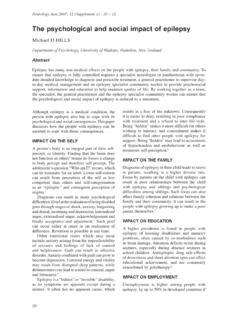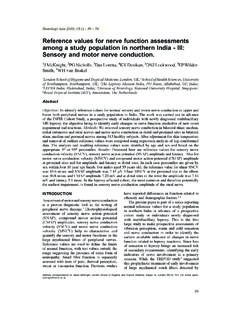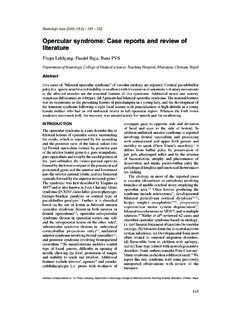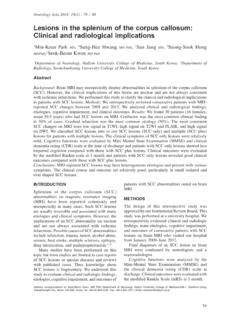Transcription of Intracranial hypotension due to shunt overdrainage ...
1 107 Intracranial hypotension due to shunt overdrainage presenting as reversible dorsal midbrain syndrome1 Meena Gupta DM, 2 Yogesh Patidar DM, 1 Geeta A. Khwaja DM, 1 Debashish Chowdhury DM, 3 Amit Batra DM, 1 Abhijit Dasgupta DMDepartment of Neurology, GB Pant Hospital, New Delhi, India; 2 Bhaktivedanta Hospital, Thane Maharashtra, India; 3 Max Super Speciality Hospital, Patparganj New Delhi, India Abstract Intracranial hypotension syndrome is an uncommon manifestation of shunt overdrainage ; characterized by a triad of postural headache, diffuse pachymeningeal gadolinium enhancement and low cerebrospinal fluid opening pressure. We describe a young female with recurrent episodes of postural headaches and reversible dorsal midbrain syndrome due to Intracranial hypotension as a complication of shunt overdrainage , and a subsequent improvement following shunt ligation.
2 Neurology Asia 2014; 19(1) : 107 110 Address correspondence to: Dr. Meena Gupta, DM (Neurology), Director, Professor, Department of Neurology, 5th Floor, Academic Block, Pant Hospital, JLN Marg, New Delhi -110002 (India). Tel: 09718599301, 011232324242 , 01123231298; Email: midbrain syndrome was first described by Parinaud H in Since then this syndrome has been also designated as Parinaud s syndrome, Sylvian aqueduct syndrome, Pretectal syndrome, and Koerber-Salus-Elschnig It is characterized by conjugate paralysis of upward gaze (occasionally down-gaze), abnormal pupillary reaction (large pupils with light-near dissociation), pathologic retraction of upper lid (Collier s sign), and convergence-retraction nystagmus on upward ,3 The syndrome reflects damage to pathway involving vertical gaze; , rostral interstitial nucleus of the medial longitudinal fasciculus, the interstitial nucleus of Cajal, the posterior commissure, and the nucleus of the posterior commissure.
3 Stroke and tumors are the common causes of dorsal midbrain ,3 Less common causes include hypoxia, trauma, multiple sclerosis, tuberculosis, neurocysticercosis, syphilis, sarcoidosis, Wilson s disease, Whipple s disease, lipid storage diseases, and certain drugs (barbiturates, carbamazepine, and neuroleptics).4-6 Dorsal midbrain syndrome has been described in obstructive hydrocephalus patients with shunt malfunction7,8 and rarely in patients with spontaneous Intracranial We describe a young female with recurrent episodes of postural headaches and reversible dorsal midbrain syndrome due to Intracranial hypotension as a complication of shunt overdrainage , and a subsequent improvement following shunt ligation. CASE REPORT A 24 year old female presented with two year history of recurrent episodes of headaches associated with vomitings, excessive sleepiness, double vision, drooping of eyelids, with downward and inward deviation of eyes.
4 There was no history of fever, loss of appetite or weight. The episodes were occurring 2-3 times per month, and most were precipitated by dehydration. All the episodes were reversible with hydration and antiemetics. Since last six months she also developed slowness in her activities of daily living, but there was no tremulousness, abnormal posturing, or falls. She had history of tubercular meningitis with communicating hydrocephalus for which she underwent ventriculoperitoneal (VP) shunting ten years back. Two of her episodes were observed during her hospital stay. Her general physical and systemic examination was unremarkable. On neurological examination during the episodes she was conscious, oriented; had bilateral complete ptosis, downward and inwards deviated eyes, impaired vertical and horizontal gaze, with middilated reacting pupils (Figure 1a,b).
5 Rest of the cranial nerves including fundus examination was normal and there were no signs of meningeal irritation. Motor system examination revealed mild axial and limb rigidity, bradykinesia, generalized hyperreflexia and mild postural instability, without any limb weakness. Sensory system and cerebellar examination was normal. A clinical diagnosis of dorsal midbrain syndrome with parkinsonism (probably drug induced) was considered. Neurology AsiaMarch 2014108 Her routine hematological and biochemical investigations, x-ray chest and abdominal ultrasound all were normal. Magnetic resonance imaging (MRI) brain revealed normal brain parenchyma, slit ventricles, flattening of the midbrain and pons, and mild diffuse pachymeningeal enhancement (Figure 2a,b,c,d). Lumbar puncture and Intracranial pressure monitoring was not done because of risk of clinical worsening.
6 With hydration and antiemetics her eye deviation and postural instability improved within 4-5 days; however her upgaze limitation and mild parkinsonian symptoms persisted (Figure 3a,b). In view of clinical and MRI findings a possibility of VP shunt overdrainage as a cause of Intracranial hypotension leading to postural headaches and reversible dorsal midbrain syndrome was considered and she underwent ligation of shunt to reduce overdrainage . For Parkinsonian symptoms she was started on tab Syndopa 125 mg four times a day. On follow up after one year she showed significant improvement with only four such episodes. All the episodes were less severe, not requiring hospitalization and all remitted within 2-3 days with hydration. Her Parkinsonian symptoms were also improved and she resume back to her work.
7 Follow up MRI brain at one year revealed mild communicating hydrocephalus with hemosiderin deposits in lentiform nuclei bilaterally (Figure 4a,b).Figure 1 a,b. During the episode, bilateral complete ptosis; eyes deviated downward and inwards with impaired vertical and horizontal 2 a,b,c,d. MRI brain (T2 axial and sagittal; T1 contrast axial and sagittal images) showing slit ventricles, flattening of the midbrain and pons, and mild diffuse pachymeningeal 3 a,b. After recovery persistent upgaze 4 a,b. Follow up MRI brain (T1 and T2 axial images) showing mild communicating hydrocephalus with hemosiderin deposits in bilateral lentiform hypotension syndrome (IHS) is an uncommon syndrome of diverse causes and variable manifestations. The syndrome may occur spontaneously, due to shunt overdrainage , or after rupture of Arachnoid cyst; or cerebrospinal fluid (CSF) leak after lumbar puncture, trauma, or cranial/spinal shunt overdrainage is seen in 10-12% of patients with VP shunts, and may manifest as slit ventricle syndrome, Intracranial hypotension syndrome, subdural fluid collections, craniosynostosis, ventricular compartmentalization, and cerebellar tonsillar ,12 The mechanism proposed are loss of normal buffering capability of CSF and reduced brain parenchymal IHS is usually a late complication reported 5-17 years after the shunt placement and commonly affects adolescents and older In our patient symptoms started eight years after VP shunt placement.
8 The characteristic triad of IHS are postural headache, diffuse pachymeningeal gadolinium enhancement and low CSF opening ,15 Although orthostatic headache is the most characteristic symptoms, patients may report chronic headaches or even no The other common symptoms are anorexia, nausea, vomiting, dizziness, blurred vision, diplopia, tinnitus, ear fullness, facial numbness, and/or neck pain; most of them are orthostatic in ,14,15 Diffuse pachymeningeal gadolinium enhancement over cerebral hemispheres was reported as the most characteristic neuroimaging feature of Intracranial hypotension , however cases without enhancement are also ,18 This enhancement is attributed to dural venous dilatation, that may extend to pachymeninges of posterior fossa and cervical The other described MRI findings are engorgement of venous sinuses, subdural fluid collections, pituitary enlargement, and downward displacement of the CSF opening pressure is usually low in patients with IHS, often 60 mm H2O.
9 However cases with orthostatic headache and diffuse pachymeningeal enhancement with normal CSF pressure have been also International Classification of Headache Disorders (ICHD-II, 2004) criteria for spontaneous Intracranial hypotension consists of (A) postural headache with one of the neck stiffness, photophobia, tinnitus, nausea, and hyperacusis; (B) the presence of at least one of the following: 1) evidence of low CSF pressure on MRI eg, pachymeningeal enhancement; 2) evidence of CSF leakage on conventional myelography, CT myelography or cisternography; 3) CSF opening pressure ( 60 mm H2O); (C) no history of dural puncture or other causes of dural fistula; and (D) headache resolves within 72 hrs after epidural blood The Intracranial hypotension in our patient was secondary to VP shunt overdrainage .
10 The diagnosis of Intracranial hypotension was based upon history of postural headaches, MRI evidence of low CSF pressure, slit ventricles, flattening of the midbrain and pons, and mild diffuse pachymeningeal enhancement. This was further supported by evidence of clinical and radiological improvement following shunt ligation. Recently, many atypical presentations of IHS are recognized including parkinsonism, ataxia, bulbar weakness, upper cervical myelopathy, frontotemporal dementia, syringomyelia, hypopituitarism, seizures, coma, and even Our patient presented with features suggestive of postural headaches and dorsal midbrain syndrome. The recurrent episodes showed nearly complete recovery with symptomatic management, with a persistent upward gaze limitation. The only other case of reversible dorsal midbrain syndrome due to Intracranial hypotension described by Fedi et al.






